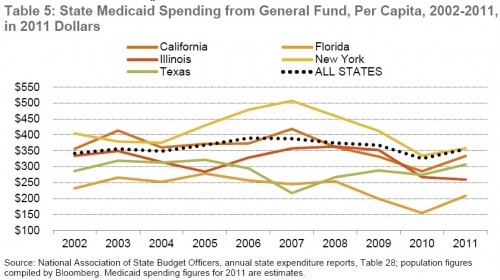In a post today they discuss a new Bloomberg Government study that suggests the Medicaid system has done a better job than private health insurers in keeping medical costs under control. This has important implications for the GOP's plan to block-grant Medicaid and Paul Ryan's plan to switch seniors over to premium support for medicare.
Key Quotes:
Inflation adjusted Medicaid spending per capita by state general funds increased just 3.8% between 2002 and 2011. This is illustrated by the dotted line in the chart below. Per capita Medicaid spending by each of the five states with the largest Medicaid programs is also shown. Though they gyrate up and down, they all end up at the end up in 2011 close to or even below where they started in 2002.
In any case, total (not per capita) real Medicaid growth was just 12% from 2002 to 2011. That’s not as high as we expected, though there is variation by state. While spending in Illinois actually decreased by 1% over this period, spending in Texas went up 58%. Moreover, this is growth above inflation, so there is room for improvement. Still, Medicaid has held spending growth below that of other payers. Flavelle quotes Vernon Smith, former Medicaid director for Michigan:
.“When you look at the rate of growth for all the major payers — Medicaid, Medicare, employer-sponsored insurance, National Health Expenditures — what you see is that no other payer has constrained the rate of growth in spending as well as Medicaid has. [] The reason is that no payer has been as motivated to undertake cost containment as state governments.”

No comments:
Post a Comment